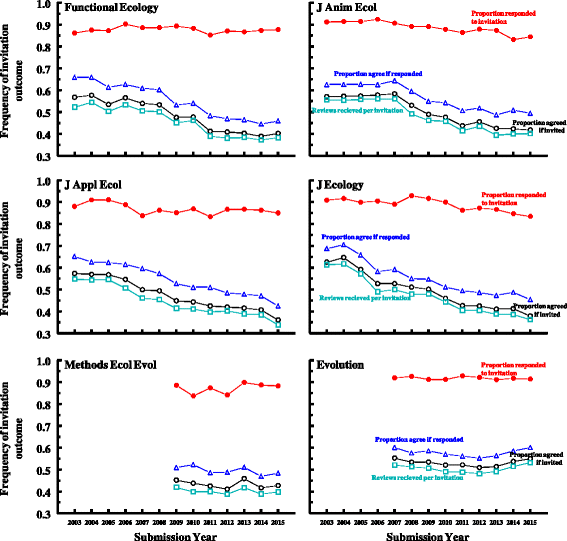Recruitment of reviewers is becoming harder at some journals: a test of the influence of reviewer fatigue at six journals in ecology and evolution
- PMID: 29451533
- PMCID: PMC5803623
- DOI: 10.1186/s41073-017-0027-x
Recruitment of reviewers is becoming harder at some journals: a test of the influence of reviewer fatigue at six journals in ecology and evolution
Abstract
Background: It is commonly reported by editors that it has become harder to recruit reviewers for peer review and that this is because individuals are being asked to review too often and are experiencing reviewer fatigue. However, evidence supporting these arguments is largely anecdotal.
Main body: We examine responses of individuals to review invitations for six journals in ecology and evolution. The proportion of invitations that lead to a submitted review has been decreasing steadily over 13 years (2003-2015) for four of the six journals examined, with a cumulative effect that has been quite substantial (average decline from 56% of review invitations generating a review in 2003 to just 37% in 2015). The likelihood that an invitee agrees to review declines significantly with the number of invitations they receive in a year. However, the average number of invitations being sent to prospective reviewers and the proportion of individuals being invited more than once per year has not changed much over these 13 years, despite substantial increases in the total number of review invitations being sent by these journals-the reviewer base has expanded concomitant with this growth in review requests.
Conclusions: The proportion of review invitations that lead to a review being submitted has been declining steadily for four of the six journals examined here, but reviewer fatigue is not likely the primary explanation for this decline.
Keywords: Peer review; Reviewer fatigue; Reviewers; Scholarly journals.
Figures



References
-
- Baveye PC, Trevors JT. How can we encourage peer-reviewing? Water Air Soil Pollut. 2011;214:1–3. http://dx.doi.org/10.1007/s11270-010-0355-7. - DOI
-
- Fox J, Petchey OL. Pubcreds: fixing the peer review process by “privatizing” the reviewer commons. Bull Ecol Soc Am. 2010;91:325–333. doi: 10.1890/0012-9623-91.3.325. - DOI
-
- Breuning M, Backstrom J, Brannon J, Gross BI, Widmeier M. Reviewer fatigue? Why scholars decline to review their peers’ work. PS: Political Science and Politics. 2015;48:595–600.
Publication types
Associated data
LinkOut - more resources
Full Text Sources
Other Literature Sources

